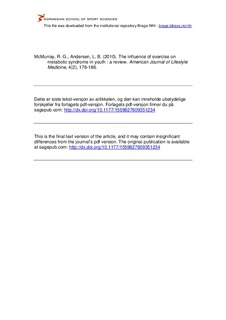| dc.contributor.author | McMurray, Robert G. | |
| dc.contributor.author | Andersen, Lars Bo | |
| dc.date.accessioned | 2011-11-02T09:07:19Z | |
| dc.date.available | 2011-11-02T09:07:19Z | |
| dc.date.issued | 2010-03 | |
| dc.identifier | Seksjon for idrettsmedisinske fag / Department of Sports Medicine | |
| dc.identifier.citation | American Journal of Lifestyle Medicine. 2010, 4(2), 176-186 | no_NO |
| dc.identifier.issn | 1559-8284 | |
| dc.identifier.issn | 1559-8276 | |
| dc.identifier.uri | http://hdl.handle.net/11250/170703 | |
| dc.description | I Brage finner du siste tekst-versjon av artikkelen, og den kan inneholde ubetydelige forskjeller fra forlagets pdf-versjon. Forlagets pdf-versjon finner du på sagepub.com: http://dx.doi.org/10.1177/1559827609351234 / In Brage you'll find the final text version of the article, and it may contain insignificant differences from the journal's pdf version. The original publication is available at sagepub.com: http://dx.doi.org/10.1177/1559827609351234 | no_NO |
| dc.description.abstract | The metabolic syndrome (MetS) is a clustering of, dyslipidemia, hypertension, glucose intolerance, and central obesity, or waist circumference that places individuals at high risk for developing cardiovascular or heart disease. Although first characterized in adults, it has been found in children; however, the definition of MetS in children is still controversial. Although MetS is most closely associated with obesity in children, two factors believed to impact MetS are physical activity (PA) and aerobic power or fitness. Studies using accelerometry to estimate PA of children have shown that low levels are associated with increased risk of developing MetS. Conversely, high levels of moderate to vigorous intensities reduce the risk. Similarly, low levels of aerobic fitness increases the likelihood of developing MetS. These effects appear to be independent of obesity. Studies have also shown that interventions that increase PA levels and improve aerobic fitness cause a reduction in MetS risk; however, an exact prescription for exercise cannot be presently provided. This review will provide an in-depth analysis of what is presently know about the relationship between MetS and PA and aerobic fitness in children. In addition, information will be presented regarding potential mechanisms for exercise to impact the major markers of MetS. | no_NO |
| dc.language.iso | eng | no_NO |
| dc.publisher | SAGE | no_NO |
| dc.subject | physical activity | no_NO |
| dc.subject | fitness | no_NO |
| dc.subject | aerobic power | no_NO |
| dc.subject | child | no_NO |
| dc.title | The influence of exercise on metabolic syndrome in youth: a review | no_NO |
| dc.type | Journal article | no_NO |
| dc.type | Peer reviewed | no_NO |
| dc.subject.nsi | VDP::Medical disciplines: 700::Health sciences: 800::Community medicine, Social medicine: 801 | no_NO |
| dc.source.pagenumber | 176-186 | no_NO |
| dc.source.volume | 4 | no_NO |
| dc.source.journal | American Journal of Lifestyle Medicine | no_NO |
| dc.source.issue | 2 | no_NO |
